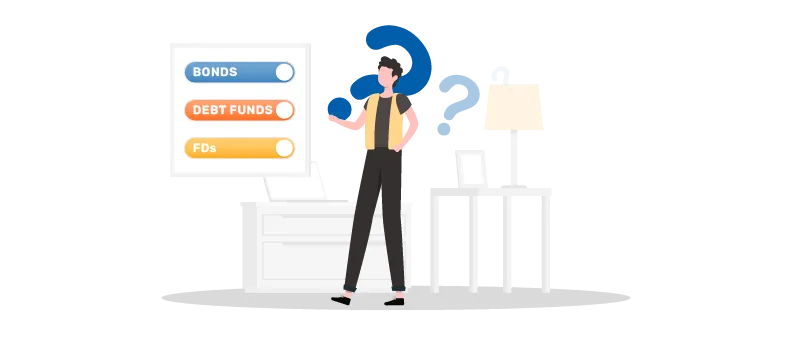Bonds, fixed deposits, debt mutual funds: Understanding the difference between fixed income options


Fixed income options can be suitable for risk-averse investors seeking a relative stable investment option although with modest return potential. These options include bonds, fixed deposits (FDs), and debt mutual funds. While all three options offer fixed income, they differ in terms of features, risks, and returns. In this article, we will explore the differences between bonds, FDs, and debt mutual funds and provide guidance on choosing the most suitable fixed income option for your investment goals.
- Table of contents
- Features of bonds
- Features of fixed deposits
- Features of debt mutual funds
- How to choose the right fixed income options?
- Bajaj Finserv AMC
- Differences between bonds, fixed deposits and debt mutual funds
Features of bonds
Bonds are debt instruments issued by governments or corporations to raise capital. When investors purchase bonds, they essentially lend money to the issuer for a fixed period. In exchange, the issuer promises to repay the principal amount along with interest at maturity. Some key features of bonds include:
- Fixed income: Bonds offer a fixed or variable rate of interest and payouts in the form of coupons.
- Credit risk: The creditworthiness of the issuer determines the stability of the bond. Investors may lose their principal if the issuer defaults on the bond. Government issued bonds are considered the most trustworthy as there is zero credit risk.
- Liquidity: Bonds can be traded on the secondary market, providing liquidity to investors.
- Diversification: Provides investors with exposure to different issuers, sectors, and maturities.
- Maturity: Bonds have a fixed maturity period ranging from a few years to several decades allowing investors to choose according to their specific requirements.
Features of fixed deposits
If we look at bond vs FD, Fixed deposits (FDs) are time deposits offered by banks and financial institutions. When investors deposit money in an FD, they earn a fixed rate of interest for a fixed period. Some key features of FDs include:
- Fixed income: FDs offer a fixed rate of interest, making them a relatively stable investment option.
- Risk: FDs are considered among the most stable fixed-income options as they are backed by the bank's reputation and government guarantees for a certain investment limit.
- Liquidity: FDs offer limited liquidity as premature withdrawals may attract a penalty.
- Maturity: FDs have a fixed maturity period ranging from a few months to several years.
- Easy accessibility: Fixed Deposits are readily offered by banks and NBFCs in India.
Features of debt mutual funds
Debt mutual funds are investment vehicles that invest in fixed income securities such as bonds, government securities, and commercial papers. They offer diversification and professional management to investors. Some key features of debt mutual funds include:
- Professional management: Investors can potentially benefit from the expertise of fund managers and their understanding of the debt markets.
- Liquidity: Debt mutual funds offer high liquidity as they can be redeemed at any time.
- Diversification: Debt mutual funds offer diversification by investing in a diverse portfolio of fixed income securities.
- Variable income: Debt mutual funds offer variable return potential depending on the underlying securities' performance.
- Credit risk: Debt mutual funds are subject to credit risk as they invest in debt securities issued by various entities of varying creditworthiness.
- Interest rate risk: Fluctuations in interest rates can affect the NAV and performance of debt funds.
How to choose the right fixed income options?
Choosing the right fixed income option among bond vs FD vs mutual fund depends on various factors, including investment goals, risk tolerance, and investment horizon. Each option offers unique benefits and considerations. Therefore, investors should carefully evaluate the features of each investment option and diversify their portfolios to achieve their investment objectives effectively. Consulting with a financial advisor can also provide personalised guidance based on individual circumstances and preferences.
Bajaj Finserv AMC
For example, the Bajaj Finserv Asset Management Company offers various debt mutual fund schemes like the Bajaj Finserv Liquid Fund, Money Market Fund, Overnight Fund, and Bajaj Finserv Banking & PSU Fund.
Differences between bonds, fixed deposits and debt mutual funds
Bonds, fixed deposits (FDs), and debt mutual funds differ in structure, risk levels, and potential returns.
Bonds:
Risk: The risk level varies based on the issuer’s creditworthiness. Government bonds are generally considered to have lower risk than corporate bonds.
Returns: Returns include coupon payments and any potential capital appreciation if sold before maturity. Interest rates and the bond's duration influence overall returns.
Liquidity: Bonds can be traded in the secondary market, but liquidity depends on the specific bond.
Fixed deposits (FDs):
Risk: FDs are generally considered relatively low-risk investments, with deposits insured up to a specified limit by the Deposit Insurance and Credit Guarantee Corporation (DICGC).
Returns: Returns are fixed for the deposit tenure, offering predictability.
Liquidity: Liquidity is limited, and premature withdrawals may result in penalties.
Debt mutual funds:
Risk: While debt funds generally carry lower risk than equity funds, the risk varies based on the credit quality and maturity of the securities in the portfolio. Credit risk arises from the possibility of issuer default, while interest rate risk can impact portfolio value when interest rates fluctuate.
Returns: Returns come from the interest earned on the underlying securities and potential capital appreciation, which can vary with market conditions.
Liquidity: Debt funds typically provide relatively high liquidity, allowing redemptions on business days.
Key differences summarized:
| Feature | Bonds | Fixed Deposits | Debt Mutual Funds |
|---|---|---|---|
| Issuer | Governments, corporations | Banks, financial institutions | Fund houses |
| Risk | Varies depending on issuer | Relatively low risk | Varies depending on portfolio holdings |
| Returns | Coupon payments, capital appreciation | Fixed interest rate | Interest income, potential capital appreciation |
| Liquidity | Can be traded, liquidity can vary | Limited, penalties for early withdrawal | Relatively high |
| Taxation | Interest income taxed as per slab | Interest income taxed as per slab | Returns taxed as per slab |
Conclusion
Bonds, FDs, and debt mutual funds are popular fixed income options that offer a relatively stable return potential. While they differ in terms of features, risks, and returns, they can each play a crucial role in a well-diversified investment portfolio. By understanding the differences between these fixed income options, investors can make informed decisions and potentially achieve their investment goals.
FAQs:
What is the difference between bonds and FDs?
Bonds are debt instruments issued by governments or corporations, while FDs are time deposits offered by banks and financial institutions. Bonds may offer a fixed or variable rate of interest and are subject to credit risk, while FDs offer a fixed rate of interest and are considered safe.
Are debt mutual funds riskier than bonds and FDs?
Debt mutual funds are subject to credit risk, market risk and other types of risks as they invest in debt securities issued by various entities. However, they offer diversification and professional management, which can mitigate some of the risks.
Can I invest in a debt mutual fund for a short-term period?
Yes, there are short-term debt mutual funds available that can be suitable for short-term investments. These funds invest in short-term debt securities and offer a relatively lower return potential compared to long-term debt mutual funds.
Which fixed income option is suitable for risk-averse investors?
For risk-averse investors, government bonds or debt mutual funds that primarily invest in government securities may be suitable. These options typically have lower credit risk compared to corporate bonds but remain subject to market risks, such as interest rate fluctuations. However, no fixed income investment is entirely risk-free.
How does liquidity differ between bonds, FDs, and debt mutual funds?
Bonds provide a fixed return if held until maturity but may have limited liquidity before then. FDs vary in liquidity based on their lock-in period. Debt mutual funds usually offer greater liquidity, allowing investors to redeem units more easily, though exit loads may apply. Each option comes with its own risk and return characteristics.
Do bonds, FDs, and debt mutual funds offer tax benefits?
None of these investment options offer any specific tax benefits in the way that some other investments might. The income they generate is generally taxable as per your individual income tax slab.
How do interest rate changes affect bonds, FDs, and debt mutual funds?
When interest rates increase, bond prices generally decline, and when rates fall, bond prices tend to rise. FD interest rates remain fixed for the deposit tenure, so they do not fluctuate with daily interest rate changes. Debt mutual funds, which invest in a portfolio of bonds, experience fluctuations in their Net Asset Value (NAV) based on prevailing interest rate movements.
Related Searches:
Mutual Fund investments are subject to market risks, read all scheme related documents carefully. This document should not be treated as endorsement of the views/opinions or as investment advice. This document should not be construed as a research report or a recommendation to buy or sell any security. This document is for information purpose only and should not be construed as a promise on minimum returns or safeguard of capital. This document alone is not sufficient and should not be used for the development or implementation of an investment strategy. The recipient should note and understand that the information provided above may not contain all the material aspects relevant for making an investment decision. Investors are advised to consult their own investment advisor before making any investment decision in light of their risk appetite, investment goals and horizon. This information is subject to change without any prior notice.
Mutual Fund investments are subject to market risks, read all scheme related documents carefully.
This document should not be treated as endorsement of the views/opinions or as investment advice. This document should not be construed as a research report or a recommendation to buy or sell any security. This document is for information purpose only and should not be construed as a promise on minimum returns or safeguard of capital. This document alone is not sufficient and should not be used for the development or implementation of an investment strategy. The recipient should note and understand that the information provided above may not contain all the material aspects relevant for making an investment decision. Investors are advised to consult their own investment advisor before making any investment decision in light of their risk appetite, investment goals and horizon. This information is subject to change without any prior notice.
The content herein has been prepared on the basis of publicly available information believed to be reliable. However, Bajaj Finserv Asset Management Ltd. does not guarantee the accuracy of such information, assure its completeness or warrant such information will not be changed. The tax information (if any) in this article is based on prevailing laws at the time of publishing the article and is subject to change. Please consult a tax professional or refer to the latest regulations for up-to-date information.